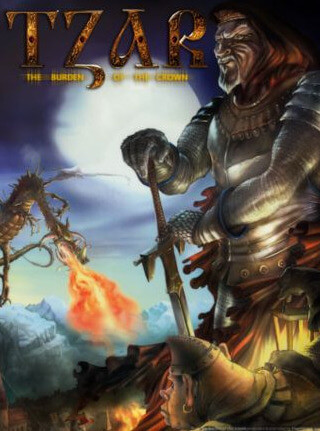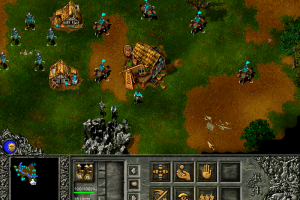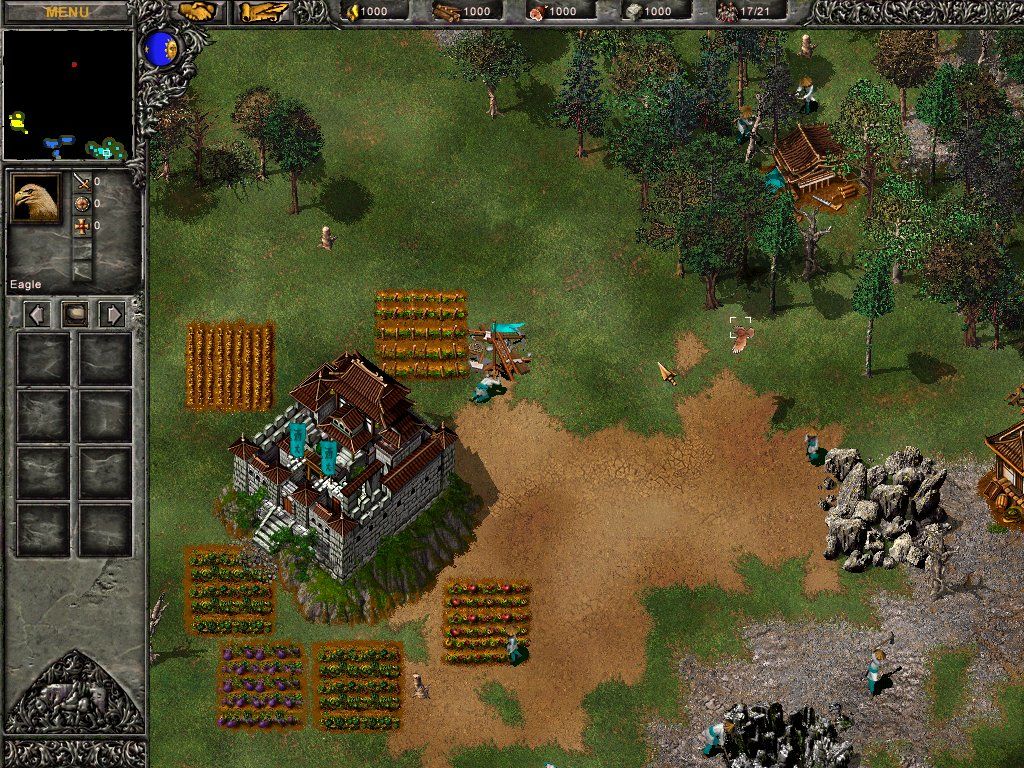A sinister evil has come to the peaceful kingdom of Keanor, a land of beauty, mystery and magic. The Palace lies in ruins as armies of malevolent warriors sweep through the countryside while the once-proud Imperial Guard cowers in fear.
| Tzar: The Burden of the Crown | |
|---|---|
| Developer(s) | Haemimont Games |
| Publisher(s) | TalonSoft FX Interactive (Italy and Spain) |
| Designer(s) | Vesselin Handjiev |
| Platform(s) | Microsoft Windows |
| Release | |
| Genre(s) | Real-time strategy |
| Mode(s) | |

Game Details: Welcome to the “Tzar: The Burden of the Crown” for Mac game page. This page contains information + tools how to port Tzar: The Burden of the Crown so you can play it on your Mac just like a normal application using Crossover. Tzar: The Burden of the Crown (c) Haemimont Games A sinister evil has come to the peaceful kingdom of Keanor, a land of beauty, mystery and magic. The Palace lies in ruins as armies of malevolent warriors sweep through the countryside while the once-proud Imperial Guard cowers in fear. Tzar puts you at the heart of the battle of good versus evil. Set in the real-time fantasy world of Keanor, where the sword is the law of the land, it is up to you to stop the armies of evil. Recruit, train and command vast armies of Knights and Archers, and build fantastic weapons to smash enemy defenses. Back in 1999, an event occurred that shook Europe. One small, but very proud company Infinite Loop that lives in Sofia, the capital of glorious Bulgaria, released some strategic game Tzar: The Burden of the Crown (the game 'Tsar: The Crown's Burden' in Russia and in general the CIS was published only in 2001 by '1C' called 'Fire and Sword').
Tzar: The Burden of the Crown, also known as simply Tzar, is a real-time strategy game for Microsoft Windows published by TalonSoft and developed by the Bulgarian game developer company Haemimont Games. The game was met with moderate success; however, it got mild recognition and audience when it was published as a demo in several gaming magazines.

The game was considered by Linux Game Publishing to be ported to Linux, but was rejected due to concerns within the company about its gameplay and after hearing negative comments about the game from the Linux gaming community.[1]
The game got a digital re-release on the GOG.com digital platform on July 16, 2013,[2] and Steam digital platform on June 6, 2019.[3]
Gameplay[edit]
The gameplay is set in a fictional medieval age. The game is a basic real time strategy game that resembles the gameplay of the Age of Empires series. The basic goal is to conquer the neighbouring kingdoms and destroy all traces of them, or destroy their castles, depending on the selected playing mode. There are many different buildings and characters player can produce, each depending on which of the three races the player chooses to play as: European, Asian or Arabian. The main differences are the types of special buildings and the types of troops available.
There are four types of resources a player has to gather: food, wood, stone and gold. Food can be gathered by harvesting crops, milking cows or killing them for meat, as well as fishing if the map has lakes or rivers. Wood is gathered by chopping down trees, and gold and stone are gathered by mining. All units have health (hit points) but sorcerers also have mana which gradually regenerates when used to cast spells or summon creatures.

The main buildings that can be constructed by all three races are houses, farms, blacksmiths, workshops, barracks, stables, towers, walls, gates and inns. The players usually starts the game with a castle and a few peasants. All types of resources can be carried to the castle. Building houses increases the population limit. Farms can be used to produce cows and also as a place to gather food. Stables are required for some types of mounted soldiers, and blacksmiths provide various improvements to units' armour and fighting skills. Workshops are used to build siege machines. Towers are used for defence. Inns are the place where the player can exchange resources and later hire mercenaries and heroes. Docks can be built to fishing and travelling across the sea.
There are 4 Strategies in which the player can take: religion (mosque- Arabians, cathedral-Europeans, Shaolin monastery-Asians), magic (mage tower-all races), war (warrior's academy-all races), or trade (merchant's guild-all races). The player takes a path by building the corresponding building. Due to the high cost of these elite buildings, the player can only take one of the strategic paths each with their own unique style:
Religion will allow the player to produce priests, spies, and elite religious unit. Priest have the ability to heal and bless units by increasing their stats for a short period of time. They also have a long line of sight to spot wizards and neutralize them with one long range shot making religion the perfect counter for a player taking the magic path. Spies have the ability to impersonate an opponent unit to infiltrate their kingdoms allowing you to see what your opponents are doing. Your opponent can command your spies and move them around or even have them collect resources if your spies impersonate an peasant. Spies can reveal their true selves at any time you give the command. Europeans elite units are crusaders which are mounted units with high armor. They come in groups at a time and the player cannot produce more until the current group is completely killed. Arabians have Jihadi warrior's which are an upgrade from a typical soldier. What makes them unique is that they are actually peasants. Peasants are much cheaper than the standard soldier suggesting the player to spam peasants and converting them to Jihadi warriors and swarm the enemy. Asian's elite unit is the monk which are all purpose warriors. They have a good balance of attack and defense and can share their battle experience with other kung-Fu units.
Magic will allow the player to produce wizards and research spells. Wizards will start out with no abilities until they are researched from the mage tower. Each race have unique spells but they are all devastating for large groups of units making magic the perfect counter against a player taking the war path. In addition, after researching, wizards can summon magical creatures - giants and bats (Europeans), genies (Arabians) and dragons (Asians). They all have outrageously high attack and hit points but are vulnerable to priests.
War will allow the player to value each soldier by removing the cap leveling up allowing them to reach heroic status as they experience more and more battles. The player can also research faster experience gain and influence by heroes. The player taking this path will be able to hire mercenaries giving quality units at no time at all. This strategic path suggests leveling up units and swarming creating hordes of experienced warriors and heroes. Despite how strong religious units are, outnumbering eventually wins making war the perfect path against a player who has taken the religious path.
The trade path allows the player to trade with allies, gamble with resources, take up loans, and increase the population cap in order to produce more peasants to collect more resources. This path is more suited when playing with allies. In addition, the trade path allows the research of elite war galleons which are larger, stronger, and have longer attack range than the other war ships making trade a considerable path to take when playing in island maps. Lastly, the player can research the ability that allows peasants to bribe enemy units as long as the price is right.
There is also a campaign option for single players in which the player must complete specific goals, such as destroying an enemy force, or protecting a citadel from attack. The campaign has a total of 20 missions.
The game also includes a map editor where players can create their own maps to play on with strategically placed rivers, forests, and resources to use to build their armies with. The game is best known for the first ever implementation of a full experience system for every unit in a RTS game.[citation needed] The game doesn't have the commonly known system of Warcraft III for heroes but still every unit has the potential to reach level twelve and thus gaining a heroic status. There is no limit of the 'hero' units a player can have, as long as they can keep them alive.
Plot[edit]
The kingdom of Keanor is under attack by dark forces and much lie in ruins. The old king has died and the son Prince Sartor's whereabouts are unknown.
Sartor is raised as a lumberjack in a village, unaware of his royal lineage as Prince. One day, mercenaries seeking Sartor raid the village, killing his uncle. A wizard named Ghiron arrives in time and saves him, revealing his royal lineage and promises to help restore the kingdom to its previous glory. Ghiron takes him to find allies, such as his father's guard captain Woolin. They save the capitol from being completely destroyed. The trio seek more and more allies, growing enough to be confident in the final battle. Having enough resources, they lead massive armies against the Messiah of Evil, the manifestation of evil on Earth.
Sartor slowly gains allies. He travels far and wide to find people. He finds allies in the Asians on a far northern continent and finds favor when he kills their old time foes. Sartor soon finds Arabian allies on a far continent. He gets taken prisoner one time and his allies break him out of his imprisonment. Eventually, he gets the confidence and his allies to find the final allies.
Then the now-King Sartor leads his army to defeat the Messiah of Evil and his city in one large battle. In the end, he recognizes that evil shall always remain.
Reception[edit]
| Aggregator | Score |
|---|---|
| GameRankings | 69%[4] |
| Publication | Score |
|---|---|
| CNET Gamecenter | 7/10[5] |
| CGM | [6] |
| CGSP | [7] |
| CGW | [8] |
| Eurogamer | 6/10[9] |
| GamePro | [10] |
| GameSpot | 6.4/10[11] |
| GameSpy | 80%[12] |
| IGN | 6.9/10[13] |
| PC Gamer (US) | 78%[14] |
| PC Zone | 65%[15] |
The game received average reviews according to the review aggregation website GameRankings.[4]
The Spanish version became a hit in Spain,[16] with sales of 50,000 units in the region by November 2000.[17]
References[edit]

Tzar The Burden Of The Crown Machinery
- ^
- ^'Release: Tzar: The Burden of the Crown'. GOG.com. CD Projekt. July 16, 2013. Archived from the original on July 20, 2013. Retrieved March 13, 2021.
- ^'Tzar: The Burden of the Crown'. Steam. Valve Corporation. Retrieved March 13, 2021.
- ^ ab'Tzar: The Burden of the Crown for PC'. GameRankings. CBS Interactive. Archived from the original on June 4, 2019. Retrieved March 13, 2021.
- ^Walker, Mark H. (April 25, 2000). 'Tzar: The Burden of the Crown'. Gamecenter. CNET. Archived from the original on August 15, 2000. Retrieved March 13, 2021.
- ^'Review: Tzar: The Burden of the Crown'. Computer Games Magazine. No. 119. theGlobe.com. October 2000. p. C5.
- ^Cobb, Jim (May 20, 2000). 'Tzar: [The] Burden of the Crown'. Computer Games Stategy Plus. Strategy Plus, Inc. Archived from the original on July 9, 2003. Retrieved March 13, 2021.
- ^Chick, Tom (July 2000). 'A Tzar Is Born (Tzar: The Burden of the Crown Review)'(PDF). Computer Gaming World. No. 192. Ziff Davis. p. 100. Archived from the original on February 11, 2001. Retrieved March 13, 2021.
- ^Bye, John 'Gestalt' (March 16, 2000). 'Tzar: [The] Burden of the Crown'. Eurogamer. Gamer Network. Archived from the original on March 29, 2001. Retrieved March 13, 2021.
- ^Olafson, Peter (May 22, 2000). 'Tzar: [The] Burden of the Crown Review for PC on GamePro.com'. GamePro. IDG Entertainment. Archived from the original on April 8, 2005.
- ^Park, Andrew Seyoon (April 18, 2000). 'Tzar: The Burden of the Crown Review [date mislabeled as 'May 2, 2000']'. GameSpot. CBS Interactive. Archived from the original on November 8, 2004. Retrieved March 13, 2021.
- ^Haumersen, Lee (April 13, 2000). 'Tzar [The Burden of the Crown]'. GameSpy. IGN Entertainment. Archived from the original on April 14, 2002. Retrieved March 13, 2021.
- ^Jojic, Uros (April 13, 2000). 'Tsar: [The] Burden of the Crown'. IGN. Ziff Davis. Retrieved March 13, 2021.
- ^Brenesal, Barry (July 2000). 'Tzar [The Burden of the Crown]'. PC Gamer. Vol. 7 no. 7. Imagine Media. p. 109. Archived from the original on February 3, 2008.
- ^Shoemaker, Richie (April 2000). 'Tzar: [The] Burden of the Crown'. PC Zone. No. 88. Dennis Publishing. p. 90. Retrieved March 13, 2021.
- ^Meix, Joan Isern (November 14, 2001). 'The Longest Journey proporciona a FX su cuarto CD-ROM de oro'. MeriStation (in Spanish). Archived from the original on September 7, 2004.
- ^Meix, Joan Isern (November 29, 2000). 'FX inicia su línea económica'. MeriStation (in Spanish). Archived from the original on November 26, 2003.

Tzar The Burden Of The Crown Macbeth
External links[edit]
- Tzared Tzar for web browsers and Android
- Tzar: The Burden of the Crown at MobyGames
- Spanish Wikipedia's entry (Useful and very detailed entry page at Spanish Wikipedia. Contains information on several games and expansions in Haemimont's Tzar: Anthology series that must be added on here too.)